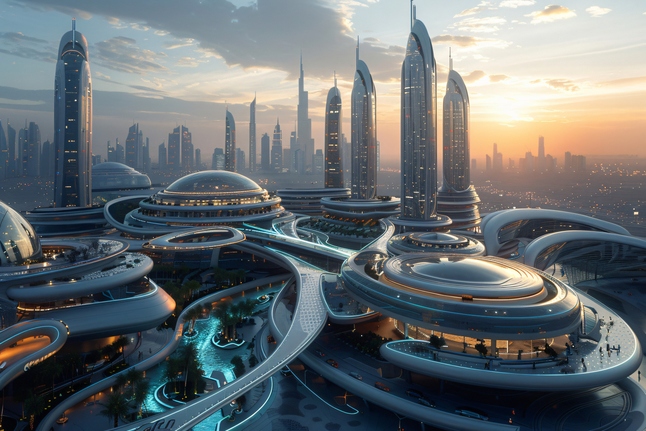
What if buildings could change shape according to your mood? What if cities suspended themselves in mid-air or entire civilizations existed below the sea? For architects and architectural students, these are more than fantasies—these are challenges. Science fiction doesn’t just speculate about distant futures; it sparks the architectural imagination. From utopia to dystopia, sci-fi challenges us to dream beyond gravity, convention, and even time.
This blog takes you through the way science fiction has influenced and continues to inspire—the built environment, offering a blueprint for futuristic thinking rooted in science, technology, and human experience.
Architecture based on Science Fiction: Building Tomorrow Today
Science fiction has long been a sandbox for architects. From the minimalist futurism of 2001: A Space Odyssey, the run-down vertical slums of Blade Runner, to the wide biomorphic buildings of Avatar, the built worlds in sci-fi movies, books, and video games are never merely backdrops—they are actors in their own right.
Architecture in science fiction has various purposes:
- A physical expression of ideology (utopia vs. dystopia)
- A device to show progress or deterioration
- A hypothetical response to new worlds (space, Mars, underwater)
- A platform for reimagining human culture and society
This is not mere fantasy. Several of these ideas are affecting actual-world design.
Real-World Designs, Fictional Roots
From around the world, architects are drawing inspiration from speculative fiction and then applying it to bold projects. These buildings don’t imitate sci-fi but resonate with its motifs—post-distribution, post-exhibition, and dialogue between technology and nature.
- Neo-Futurism and Parametric Design
- Zaha Hadid Architects, such as the Galaxy SOHO in Beijing, share a visual language reminiscent of interstellar operas.
- Aided by the curving, otherworldly shapes of science fiction, these structures erase the distinction between building and sculpture.
- High-Tech Sustainability
- The geodesic biomes of the Eden Project in the UK would readily accommodate the last living remnants of Earth’s biodiversity in a post-apocalyptic world.
- Algae-powered facades and vertical farms revisit ideas first sown in 1960s science fiction books.
- Floating and Flying Cities
- Ideas like Oceanix City, a modular floating habitat, demonstrate increased urgency over climate change and sea rise, mirroring the world-building of Waterworld or Snowpiercer.
- Cities of drone ports and space elevators have progressed from Arthur C. Clarke’s imagination to architectural studies of feasibility.
Iconic Sci-Fi Worlds as Design Inspiration
The following is some of the speculative worlds that have become unofficial case studies for architects
- Coruscant (Star Wars): A vertically layered planetary city, coping with density, politics, and surveillance
- The Grid (Tron: Legacy): Data flow-inspired digital architecture on the minimalist and programmable facade.
- Wakanda (Black Panther): Afro-futurist paradise with tradition collaborating with tech, highlighting cultural context in future cities.
- TARS Habitat (Interstellar): Modular, functionality-oriented dwelling for harsh environments, already shaping Mars habitat prototypes.
Sci-Fi Architectural Tools: Concepts to Study and to Steal
For architecture students, science fiction is not just about looks—it’s process. These are fundamental design principles built into predictive futures:
- Speculative Urbanism: Imagine your city without streets. Without gravity. Without fossil fuels.
- World-Building as Site Analysis: Think designing in a hypothetical future where water is money, or oxygen is limited.
- Responsive Environments: Draw from AI-connected homes like in Her and discover how buildings could respond in real-time to user demands.
Why It Matters: Architecture as Cultural Time Machine
Architecture that’s sci-fi-inspired enables time travel—not backward or forward, but sideways. It permits us to consider possibilities. In a career customarily bound by regulation, price, and convention, speculative design brings freedom.
But above all, it holds architects accountable. If we’re designing the future, whose future do we intend to create?
Closing Blueprint: Design for the Unwritten
Science fiction is not prophecy—it’s a challenge. Every drawing of a flying city or terraformed dome is a call to create. To architects and students everywhere: don’t wait for tomorrow. Design it.
Key Takeaways:
- Sci-fi is a design lens, not a genre.
- Futuristic stories inform sustainable, adaptive, and richly cultural designs.
- Utilize world-building as a tool in architecture to challenge assumptions.
- Each constructed world is a critique or celebration of our own.
Architecture doesn’t merely construct space—it constructs time. Sci-fi allows you to have the opportunity to work in centuries, galaxies, and dimensions to be.
